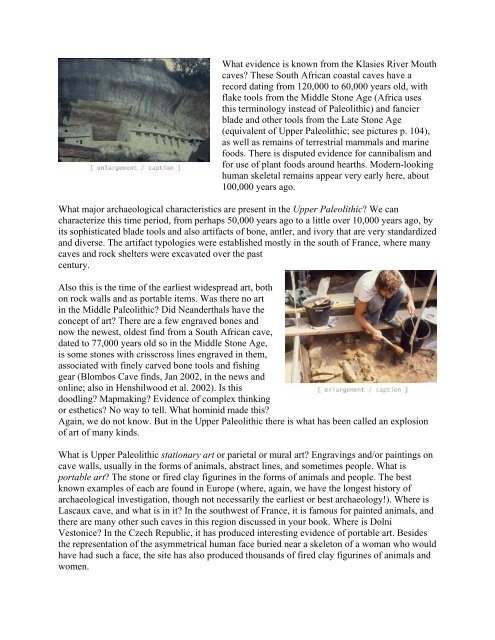INTRODUCTION TO ARCHAEOLOGY Nancy White - Touro Institute
INTRODUCTION TO ARCHAEOLOGY Nancy White - Touro Institute
INTRODUCTION TO ARCHAEOLOGY Nancy White - Touro Institute
Create successful ePaper yourself
Turn your PDF publications into a flip-book with our unique Google optimized e-Paper software.
What evidence is known from the Klasies River Mouth<br />
caves? These South African coastal caves have a<br />
record dating from 120,000 to 60,000 years old, with<br />
flake tools from the Middle Stone Age (Africa uses<br />
this terminology instead of Paleolithic) and fancier<br />
blade and other tools from the Late Stone Age<br />
(equivalent of Upper Paleolithic; see pictures p. 104),<br />
as well as remains of terrestrial mammals and marine<br />
foods. There is disputed evidence for cannibalism and<br />
for use of plant foods around hearths. Modern-looking<br />
human skeletal remains appear very early here, about<br />
100,000 years ago.<br />
What major archaeological characteristics are present in the Upper Paleolithic? We can<br />
characterize this time period, from perhaps 50,000 years ago to a little over 10,000 years ago, by<br />
its sophisticated blade tools and also artifacts of bone, antler, and ivory that are very standardized<br />
and diverse. The artifact typologies were established mostly in the south of France, where many<br />
caves and rock shelters were excavated over the past<br />
century.<br />
Also this is the time of the earliest widespread art, both<br />
on rock walls and as portable items. Was there no art<br />
in the Middle Paleolithic? Did Neanderthals have the<br />
concept of art? There are a few engraved bones and<br />
now the newest, oldest find from a South African cave,<br />
dated to 77,000 years old so in the Middle Stone Age,<br />
is some stones with crisscross lines engraved in them,<br />
associated with finely carved bone tools and fishing<br />
gear (Blombos Cave finds, Jan 2002, in the news and<br />
online; also in Henshilwood et al. 2002). Is this<br />
doodling? Mapmaking? Evidence of complex thinking<br />
or esthetics? No way to tell. What hominid made this?<br />
Again, we do not know. But in the Upper Paleolithic there is what has been called an explosion<br />
of art of many kinds.<br />
What is Upper Paleolithic stationary art or parietal or mural art? Engravings and/or paintings on<br />
cave walls, usually in the forms of animals, abstract lines, and sometimes people. What is<br />
portable art? The stone or fired clay figurines in the forms of animals and people. The best<br />
known examples of each are found in Europe (where, again, we have the longest history of<br />
archaeological investigation, though not necessarily the earliest or best archaeology!). Where is<br />
Lascaux cave, and what is in it? In the southwest of France, it is famous for painted animals, and<br />
there are many other such caves in this region discussed in your book. Where is Dolni<br />
Vestonice? In the Czech Republic, it has produced interesting evidence of portable art. Besides<br />
the representation of the asymmetrical human face buried near a skeleton of a woman who would<br />
have had such a face, the site has also produced thousands of fired clay figurines of animals and<br />
women.
















